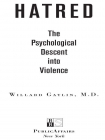Hatred, Willard Gaylin [best ebook for manga txt] 📗

- Author: Willard Gaylin
Book online «Hatred, Willard Gaylin [best ebook for manga txt] 📗». Author Willard Gaylin
Out of the masses emerged a strong middle class with the kind of secular life that would be less easy to sacrifice for the admittedly grander, but less certain, future in heaven.80 As life approximated in richness the qualities ascribed to an afterlife, it would be harder to abandon that which we know—the bird in the hand—for that which was only promised. Still, conditions would arise where a population filled with frustration, resentment, and despair would be ripe and waiting for an explosion into hatred. Max Scheler labeled this emotional state as ressentiment, and he described it as a dangerous, pathological, and destructive condition. Ressentiment is not exactly translatable to resentment, as it is more powerful than that, a toxic brew of resentment, envy, spite, rage, and revenge: “Ressentiment can only arise if these emotions are particularly powerful and yet must be suppressed because they are coupled with the feeling that one is unable to act them out—either because of weakness, physical or mental, or because of fear.”81
Scheler described this condition as endemic in the Germany of 1912 in which he was writing. Twenty years or so later, the conditions were only intensified. In the period following the massive defeat of Germany in World War I, a nation emerged that was joined in humiliation and impoverishment. With the coming to power of a paranoid leadership—obsessed with a virulent anti-semitism born out of the leaders’ individual psyches—a new Germany emerged. Democracy was replaced with a Fascist dictatorship. The pathological leaders offered a paranoid justification for the feelings of the Germans that relieved them of responsibility and supplied them with a culpable enemy. The qualities of both religion and statehood were combined under the Nazis. And then to supply passion and justification, a religious and mystical mission was offered. A crusade was initiated with the emphasis on protecting not just the people or the state but the purity of the Aryan “race.” The Holocaust became a reality.
Ultranationalist dictatorships share certain characteristics of religious orthodoxy but these qualities are joined with the military powers of the state. When one combines the two, as is so common now in the Arab world, it becomes apparent why the Islamic state is now viewed as a center for international terrorism.
The work of Al Qaeda, the ideological community, is also supported by its fundamentalist assumptions. It is supported in its efforts by the existence of theocratic dictatorships throughout the Middle East, which erase the traditional balance of power between national and religious interests, limiting the excesses of either. With Al Qaeda the role of religion is central and all-powerful. Religion creates, encourages, rationalizes, and supports hatred—and supplies enemies, the infidel. Al Qaeda is particularly effective in its capacity to wreak havoc because it attaches its religious fanaticism to political struggles, operating as both a political movement and a religious crusade.
Al Qaeda has been described as the Muslim version of the Christian Crusades. The comparison is grossly inexact. The assumption is that because the Crusades represented the particular ideologies of a religion—the Christians—it was an ideological action. It was, in fact, a territorial one. When Pope Urban II gave his clarion call at the Council of Clermont in 1095, his purposes were clear. The object was not conversion of the heathen, but the liberation of the Holy Sepulcher in Jerusalem. It is generally agreed that the primary mission of the Church was gaining access to the holy places, whereas the promise of power and wealth motivated the secular leaders who actually mobilized the troops and initiated the actions. One of the major positive consequences of the Crusades was the creation of a larger community of interests and contact. The world of the West was enlarged, enriched, and complicated by its exposure to the East.
The modern networks of communication facilitated the formation of Al Qaeda. But what is the articulated purpose of this crusade? What is its Holy Sepulcher? What does Al Qaeda want? The easy answer is the security of a Palestinian state. That certainly is the goal of the Palestinian terrorist. But Al Qaeda is not motivated by the establishment of something. It is the destruction of something that Al Qaeda wants. But what is it? Some would say the destruction of the state of Israel. But the evidence and the chronology of their activities belie that. When they began to mention Israel, it seemed to come only as an afterthought. Destroying Israel appears to be an opportunistic claim, a Johnny-come-lately plan. Their true venom seems to be more directed to Jews in general as representative of the larger host of infidels.
Al Qaeda leaders, by embracing a general antisemitism, have now joined a traditional bigotry. They have found the one-size-fits-all enemy, the Jews. They send tanker trucks to destroy a Jewish synagogue in Tunisia and people with bombs to destroy Jewish cultural institutions in France. Israel appears to be a temporary convenience for Al Qaeda, a rationalization created to influence the liberal communities of Europe that have been offended by the Israeli occupation of the West Bank, and impatient at the lack of progress in a peace settlement. Israel is most likely a way station for Al Qaeda in its jihad against the hated modern state.
One suspects that the attacks on Jewish (not Israeli) targets in Europe and North Africa represent a temporary and safer alternative to the “Jewish schools and neighborhoods in the United States” that Al Qaeda indicated were to be its prime targets. And what perfect targets! By assaulting these American-Jewish institutions, it





Comments (0)